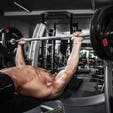What is Powerlifting?
It’s similar to Olympic lifting in that a competitor gets three attempts to lift a maximal weight, but instead of the snatch and clean and jerk, powerlifting uses the squat, bench press, and deadlift. The winner is determined by adding up the lifter’s best successful attempt in each.
It evolved from the “odd lifts,” which were more similar to strong man events, but became standardized in the 1950’s as Olympic lifting saw a decline in popularity. Alright, relax, history lesson is almost over…
It used to be on ESPN where guys like Ed Coan and Steve Goggins went head to head, weight for weight on the platform. It was their generation’s Crossfit. But it’s still around today, and has evolved into a strong subculture that influences every aspect of strength training from the average individual up to college and professional athletics. Guys like Joe Defranco would attest to this.
Now I’m not Joe Defranco. But each of my lifts are ranked in the top ten in the world and I’m currently ranked #2 in the world (total) in the 242lb weight class. I’ve squatted 804, benched 534, and deadlifted 734 in competition. So let me share with you how I got to where I am, and how it can help you.
The Breakdown on Powerlifting for Unconventional Trainers
First let’s look at each lift and determine what its benefits are when executed properly. The squat is the king. If you want to be powerful you have to learn to squat, and squat big. You don’t have to weigh 300lbs to have a big squat. I’ve seen 130lb women squat 400+ and they are fit! Squats will build leg strength, teach you balance, and force your body to work together as a whole.
You will also gain some strength in the posterior chain (glutes, hamstrings, low back) as well as the middle and upper back. This is great for overall health in maintaining good posture, especially for those of us that work jobs where we might be forced to sit at a desk for extended periods of time.
The bench is obvious, but then again it can have some upside that you’re missing out on. A proper bench involves every muscle in your body, not just your chest and triceps. If you go to a commercial gym, the bench pressing you see there will only involve the chest and triceps because they’re doing it wrong.
Your rear delts and lats are forced to stabilize and lower the weight. Your legs should be tense and ready to fire the weight up in conjunction with your upper body. Your knuckles should be white because you’re gripping the bar as tight as possible. It’s a full body workout if you’re doing it right. And that takes practice and hopefully a good trainer.
Finally the most fun of the three, the deadlift. It takes number two to the squat, but it’s a close second. Deadlifts will build muscle mass and develop pure strength. What do I mean by ‘pure strength’? It’s a “dead”lift because there is no eccentric phase to the movement- it is purely concentric. So the descent in the squat and bench is the eccentric, and the reversal is the concentric (think contraction).
That means your muscles have the opportunity to coil or load up. Not the case in the deadlift. It’s that exact reason why it is the most taxing on your Central Nervous System. So training it heavy is great, but you will likely need more rest between heavy deadlift training sessions than you might for other lifts, including unconventional training.
To give them their due diligence, I don’t train the Olympic lifts because they have no benefit for my style of competition. Both are extremely technical lifts to learn, and take years of practice and patience. However, training them will teach you how to be explosive which is essential in moving heavy weights. As with any of these movements, have a professional train you on how to perform them safely and properly.
What Can Powerlifting Movements do for Unconventional Trainers?
Force= mass x acceleration.
To create more force you have to be faster. One way to get faster is to have more muscle. More muscle fibers to call on means more troops for the battle.
- The big three, when programmed and performed correctly, will increase your strength levels. So that 50lb kettlebell you’re swinging will start to feel like that old 25lb’er you used to hate. Unconventional Training is great in the sense that it trains the body as one unit, leaving almost no muscle groups behind. Understand there are a million ways to skin a cat, sometimes one is better than the other.
- The big three will increase your muscle mass. I used to be skinny. I didn’t like it. You don’t have to be big, but it is nice to have a little bulge in the bicep or a firm ass or some big traps. Whatever you like, you can get there faster with these movements.
- The big three will bring up weak muscle groups all at once. Kettlebells and Steel Clubs will force weaker muscles into working harder to catch up, but that is accelerated once you really raise the weight on the bar. I’m not talking about throwing on a ton of weight and lifting with poor form, but slowly bringing up your intensity (i.e. the weight being lifted) with good technique will kick your weaker muscle groups in the ass. You’ll be sore in places you didn’t know you had.
Powerlifting With Unconventional Training
There are literally a million different ways you can incorporate these movements into your unconventional training. I’ll give you a couple of ideas as to how I would do it, but it will depend on how many days per week you train, what your goals are, and what equipment you have available. Let’s say Johnny wants to put on a couple pounds of muscle…
Monday– deadlift sets of 5 up to 25 total reps (so 5×5, 5 sets of 5 reps)
Wednesday- bench sets of 5 up to 25 total reps
Friday– squat sets of 5 up to 25 total reps
- After you perform these movements go into your unconventional training. You should be a little more fatigued than normal, but that’s a good thing.
- The second week you can change your rep scheme to 3×3, doing more weight than week 1. And the third week you can do 5 sets of single reps, doing more weight than week 2. Finally, on the fourth week cut the weight in half from week three, and perform 3 sets of 8-10 reps with that weight.
Back at it again on Week 5, repeating the process but trying to add a minimum of 5lbs to what you did the last time.
Let’s say Johnny just wants to gain some strength, but isn’t as concerned about adding muscle…Another option might be to dedicate one or two days per week to power movements, where you perform all three in the same training session albeit at a slightly lower intensity (i.e. less weight). You can use a similar rep scheme as above, but one or two days you will squat, bench, and deadlift. The rest of your training days will be devoted to unconventional training.
Once you find what set up works best for you, research a program and stick with it. Give it six months before you decide whether it’s working or not. Results take months or years- READ it won’t happen overnight. But if you can increase your strength with these movements then you’ll be able to push yourself harder when using kettle bells, steel clubs, battle ropes, etc because you have more muscle fibers to recruit. More muscle fibers means more power. Everyone can use a little more power now and then.
Photo Credit: Ken Hicks Elitefts.com Inc ©elitefts
Increase Your Powerlifting Strength
If you are looking for quality supplementation, to aid your powerlifting or unconventional training look no further than Onnit T plus. The Florida State Powerlifting team just performed a trial of this product with great results. I did my own analysis of T+, long before the study results came out. I initiated supplementation and carefully logged my results. I noticed findings very similar to what the FSU team was able to demonstrate. But I guess now the secret is out, and I’ll just have to work a little bit harder. Fortunately for me, I’ve got a head start.
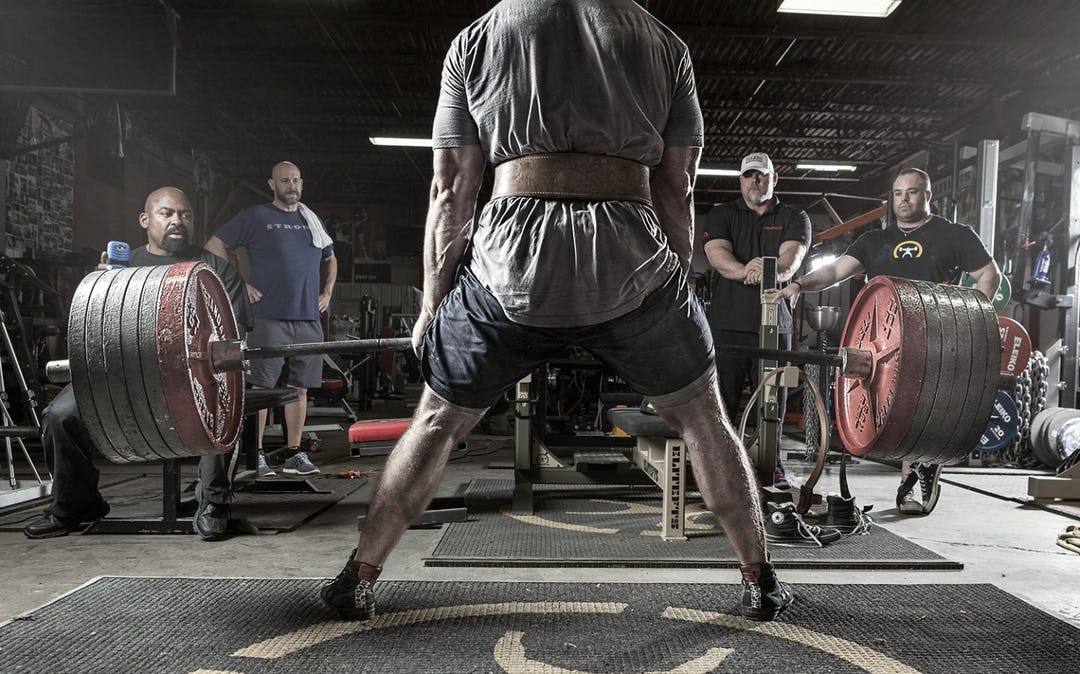
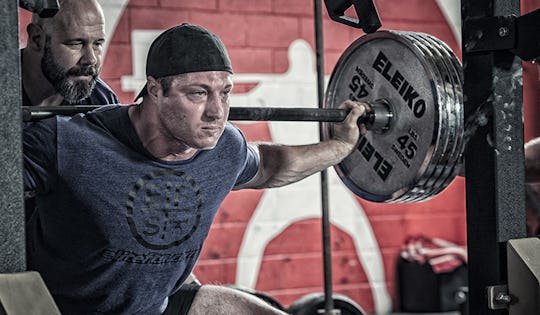
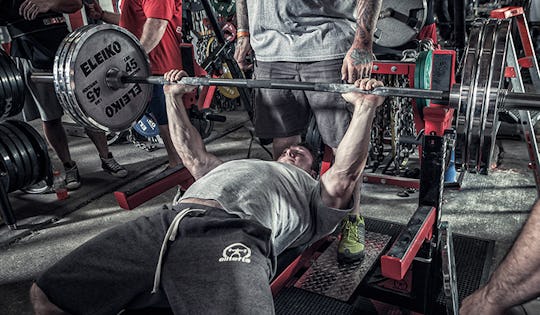
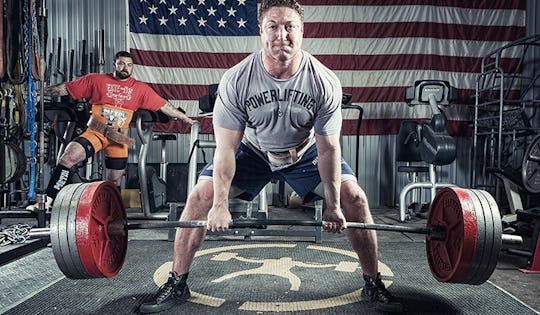
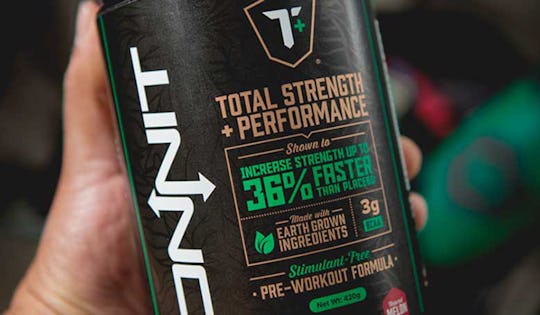
)



